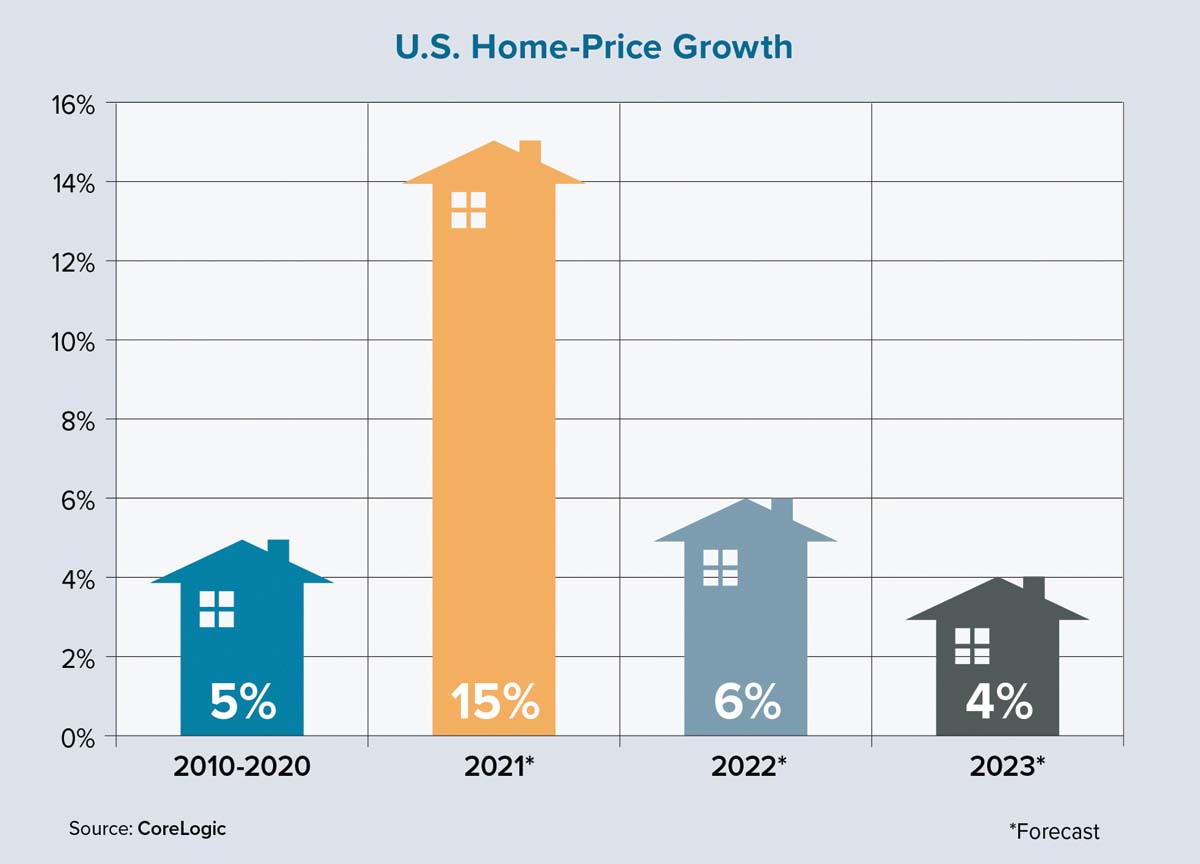Last year was an extraordinary one for the U.S. housing market — record-low interest rates, record-high annual growth for single-family home prices and rents, foreclosure rates at a generational low and the largest number of home sales in 15 years. Home sellers benefited from a market in which their properties sold quickly and often above list price as multiple buyers competed for the winning bid.
With the Federal Reserve gradually tapering its supportive monetary policy, long-term yields should slowly rise in the coming year. Look for interest rates on 30-year fixed-rate mortgages to average about 3.4% in 2022, or about half a percentage point higher than they were in 2021. Even with this increase, mortgage rates will remain historically low. In the decade prior to the COVID-19 pandemic (2010-2019), rates for 30-year fixed-rate loans averaged 4.1%.
In the coming year, expect to see a moderation in buyer demand as the erosion in affordability takes a toll and additional for-sale inventory arrives on the market. With more supply due to new construction and existing homeowners who choose to relocate, CoreLogic expects nationwide home sales to rise to their highest level since 2006. With demand easing, homes listed for sale will be on the market a bit longer due to fewer competing bids, which should moderate price growth.
The CoreLogic Home Price Index forecast expects the average annual increase across the U.S. to slow from 15% in 2021 to 6% in 2022 and 4% in 2023. The month-over-month, seasonally adjusted growth in the national index has started to moderate from the rapid pace seen this past spring. While price growth remained rapid through this past September, the seasonally adjusted monthly growth rates were slower compared to the springtime, a sign that further price-growth moderation is likely on the way.
Rent growth for single-family homes reached an all-time high as recorded by the CoreLogic Single-Family Rent Index. Annualized rent growth surged to 10.2% in September 2021 but is projected to slow as additional rental properties enter the market.
While home-purchase originations should rise, higher mortgage rates will reduce refinance originations and alter their composition. The refi market will likely include a much larger cash-out share in 2022 as homeowners tap record amounts of home equity to finance additions and renovations, consolidate debt or support other purchases.
On average, refi borrowers will likely have slightly lower credit scores, too, as Federal Housing Administration borrowers with sufficient equity refinance into conventional products with loan-to-value ratios of 80% or less to avoid mortgage insurance. Borrowers who refinance when interest rates have started to rise also prefer to keep monthly payments low — and they can do so by lengthening their loan term. Look for a gradual increase in the average maturity for refi loans in 2022.
Employment and income growth should continue to keep mortgage delinquencies at a very low level. The end of foreclosure moratoriums and the federal forbearance program will likely result in a rise in distressed home sales in 2022, but this increase will be small. This is because the large increase in home values over the past year has caused equity to build up. A CoreLogic analysis found that less than 2% of borrowers in forbearance had no home equity as of September 2021.
The coming year should be a strong one for the housing and mortgage industries. Look for mortgage rates to rise while remaining historically low and for home sales to increase to a 16-year high mark. Additionally, home-price and rent growth will slow, refinances will shift toward cash-out products and delinquency rates will remain low albeit with an uptick in distressed sales. ●
Author
-

Frank E. Nothaft is chief economist for CoreLogic, America’s largest provider of advanced property and ownership information, analytics and data-enabled services. He leads the economics team responsible for analysis, commentary and forecasting trends in global real estate, insurance and mortgage markets. Before joining CoreLogic, Nothaft served as chief economist for Freddie Mac. Prior to Freddie Mac, he was an economist with the Board of Governors of the Federal Reserve System.




